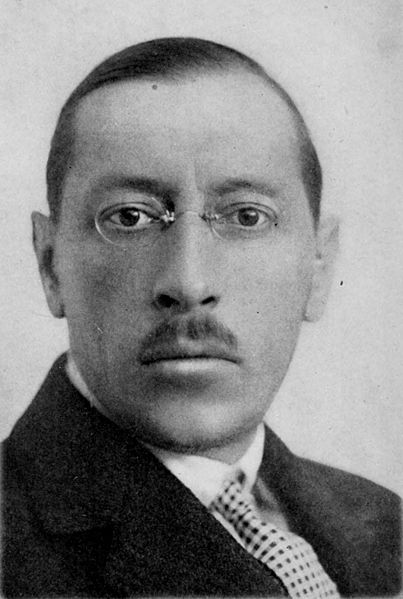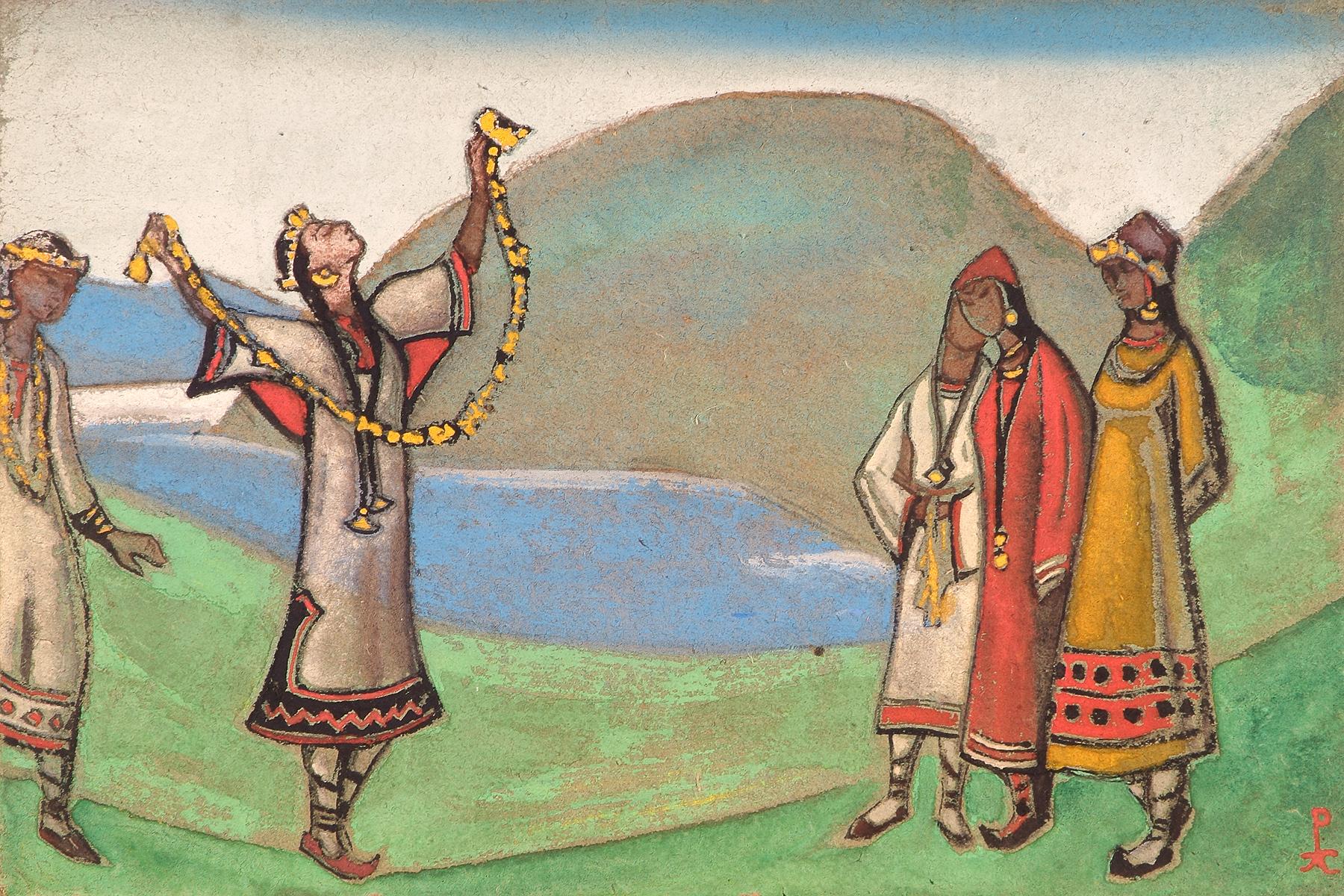June 17, 2013.Stravinsky and the Rite of Spring.Igor Stravinsky was born on this day in 1882, but just a couple weeks ago we passed another significant milestone: the one hundredth anniversary of the premier of Le Sacre du printemps, or The Rite of Spring, his seminal achivement.The event took place in Paris on May 29, 1913 in the newly opened Théâtre des Champs-Élysées.The ballet was performed by Sergei Diaghilev’s Ballets Russes company; it was choreographed by Vaslav Nijinsky; Nikolai Roerich created the costumes and stage design.Stravinsky, then 31 years old, was already successful and quite famous.Three years earlier he wrote music for his first ballet, The Firebird, also for Ballets Russe (Diagilev, the impresario, first approached more established composers, Liadov and Tcherepnin, but eventually gave the commission to Stravinsky).The Firebird was a triumph, a breakthrough both for Stravinsky and Diagilev, who immediately asked the composer to collaborate with him on another project.Stravinsky proposed The Great Sacrifice, a ballet he was discussing with Nikolai Roerich, which would eventually become The Rite of Spring; and Diagilev agreed.Stravinsky started working on it the same year, 1910, but soon switched to a different project; Diagilev, with his keen ear, decided that it’s worth staging, and soon Petrushka was born.If anything, it was even more successful than The Firebird: the immensely talented Vaslav Nijinsky danced the title role, created for him by Mikhail Fokine, and the celebrated painter Alexandre Benois designed the sets.Soon after the premier Stravinsky returned to The Rite.He was living in Clarens, a village on the shores of Lake Geneva, working in a small room with a piano and practically no furniture.He completed the first half (The Adoration of the Earth) in the summer of 1912, and even prepared a version for four hands, which he performed with Claude Debussy in Paris.The second half (The Sacrifice) and the orchestration were finished in March of 1912.He showed the score to Maurice Ravel, who thought it a very important piece of music.Pierre Monteux, then the conductor of the Ballets Russes and not a big fan of the score, suggested some changes that Stravinsky accepted.
The premier turned into a major scandal.Protests started almost from the beginning, even before the curtain rose to reveal the stamping dancers, and it went downhill from there.Witnesses said that the audience was screaming so loudly that it was almost impossible to hear the music.Stravinsky soon left the hall and watched the rest of the performance from the wings.Both the music and Nijinsky’s choreography were offensive to many in the audience.With passions heating up, a fight broke out in the hall.Eventually people’s ire turned to the orchestra and all kinds of things flew into the pit; the stoic Monteux continued conducting without interruptions (several arrests were made after the performance).The public settled down somewhat during the second half; there were even curtain calls at the end.Some critics thought the music “barbarous,” and it’s said that Camille Saint-Saëns left the theater in disgust; Puccini called the music “cacophony.”This didn’t stop Diagilev from taking the troupe to London, were the response was not as hostile.Critical opinion, however, changed rather quickly.These days The Rite is acknowledged as one of the most influential pieces of music of the 20th century, a masterpiece that influenced generations of composers.It’s also one of the most often recorded compositions.We’ll hear it in the performance by the San Francisco Symphony Orchestra, Michael Tilson Thomas conducting.
Stravinsky and the Rite of Spring
June 17, 2013. Stravinsky and the Rite of Spring. Igor Stravinsky was born on this day in 1882, but just a couple weeks ago we passed another significant milestone: the one hundredth anniversary of the premier of Le Sacre du printemps, or The Rite of Spring, his seminal achivement. The event took place in Paris on May 29, 1913 in the newly opened Théâtre des Champs-Élysées. The ballet was performed by Sergei Diaghilev’s Ballets Russes company; it was choreographed by Vaslav Nijinsky; Nikolai Roerich created the costumes and stage design. Stravinsky, then 31 years old, was already successful and quite famous. Three years earlier he wrote music for his first ballet, The Firebird, also for Ballets Russe (Diagilev, the impresario, first approached more established composers, Liadov and Tcherepnin, but eventually gave the commission to Stravinsky). The Firebird was a triumph, a breakthrough both for Stravinsky and Diagilev, who immediately asked the composer to collaborate with him on another project. Stravinsky proposed The Great Sacrifice, a ballet he was discussing with Nikolai Roerich, which would eventually become The Rite of Spring; and Diagilev agreed. Stravinsky started working on it the same year, 1910, but soon switched to a different project; Diagilev, with his keen ear, decided that it’s worth staging, and soon Petrushka was born. If anything, it was even more successful than The Firebird: the immensely talented Vaslav Nijinsky danced the title role, created for him by Mikhail Fokine, and the celebrated painter Alexandre Benois designed the sets. Soon after the premier Stravinsky returned to The Rite. He was living in Clarens, a village on the shores of Lake Geneva, working in a small
May 29, 1913 in the newly opened Théâtre des Champs-Élysées. The ballet was performed by Sergei Diaghilev’s Ballets Russes company; it was choreographed by Vaslav Nijinsky; Nikolai Roerich created the costumes and stage design. Stravinsky, then 31 years old, was already successful and quite famous. Three years earlier he wrote music for his first ballet, The Firebird, also for Ballets Russe (Diagilev, the impresario, first approached more established composers, Liadov and Tcherepnin, but eventually gave the commission to Stravinsky). The Firebird was a triumph, a breakthrough both for Stravinsky and Diagilev, who immediately asked the composer to collaborate with him on another project. Stravinsky proposed The Great Sacrifice, a ballet he was discussing with Nikolai Roerich, which would eventually become The Rite of Spring; and Diagilev agreed. Stravinsky started working on it the same year, 1910, but soon switched to a different project; Diagilev, with his keen ear, decided that it’s worth staging, and soon Petrushka was born. If anything, it was even more successful than The Firebird: the immensely talented Vaslav Nijinsky danced the title role, created for him by Mikhail Fokine, and the celebrated painter Alexandre Benois designed the sets. Soon after the premier Stravinsky returned to The Rite. He was living in Clarens, a village on the shores of Lake Geneva, working in a small room with a piano and practically no furniture. He completed the first half (The Adoration of the Earth) in the summer of 1912, and even prepared a version for four hands, which he performed with Claude Debussy in Paris. The second half (The Sacrifice) and the orchestration were finished in March of 1912. He showed the score to Maurice Ravel, who thought it a very important piece of music. Pierre Monteux, then the conductor of the Ballets Russes and not a big fan of the score, suggested some changes that Stravinsky accepted.
room with a piano and practically no furniture. He completed the first half (The Adoration of the Earth) in the summer of 1912, and even prepared a version for four hands, which he performed with Claude Debussy in Paris. The second half (The Sacrifice) and the orchestration were finished in March of 1912. He showed the score to Maurice Ravel, who thought it a very important piece of music. Pierre Monteux, then the conductor of the Ballets Russes and not a big fan of the score, suggested some changes that Stravinsky accepted.
The premier turned into a major scandal. Protests started almost from the beginning, even before the curtain rose to reveal the stamping dancers, and it went downhill from there. Witnesses said that the audience was screaming so loudly that it was almost impossible to hear the music. Stravinsky soon left the hall and watched the rest of the performance from the wings. Both the music and Nijinsky’s choreography were offensive to many in the audience. With passions heating up, a fight broke out in the hall. Eventually people’s ire turned to the orchestra and all kinds of things flew into the pit; the stoic Monteux continued conducting without interruptions (several arrests were made after the performance). The public settled down somewhat during the second half; there were even curtain calls at the end. Some critics thought the music “barbarous,” and it’s said that Camille Saint-Saëns left the theater in disgust; Puccini called the music “cacophony.” This didn’t stop Diagilev from taking the troupe to London, were the response was not as hostile. Critical opinion, however, changed rather quickly. These days The Rite is acknowledged as one of the most influential pieces of music of the 20th century, a masterpiece that influenced generations of composers. It’s also one of the most often recorded compositions. We’ll hear it in the performance by the San Francisco Symphony Orchestra, Michael Tilson Thomas conducting.